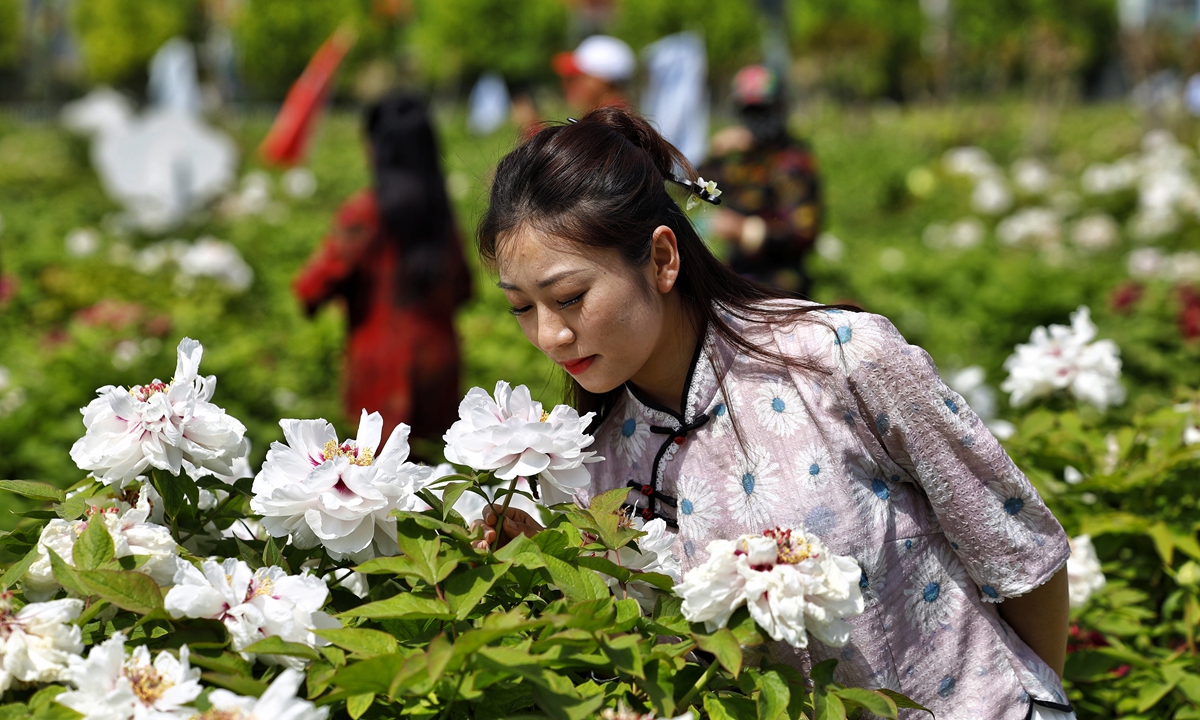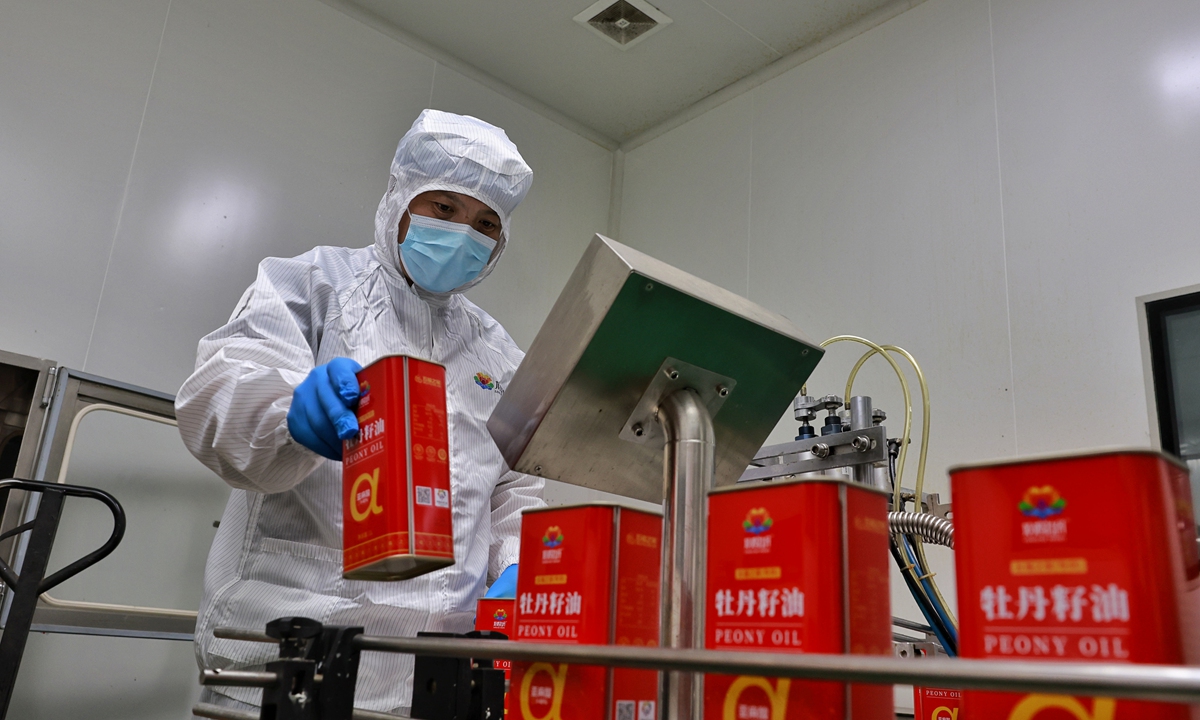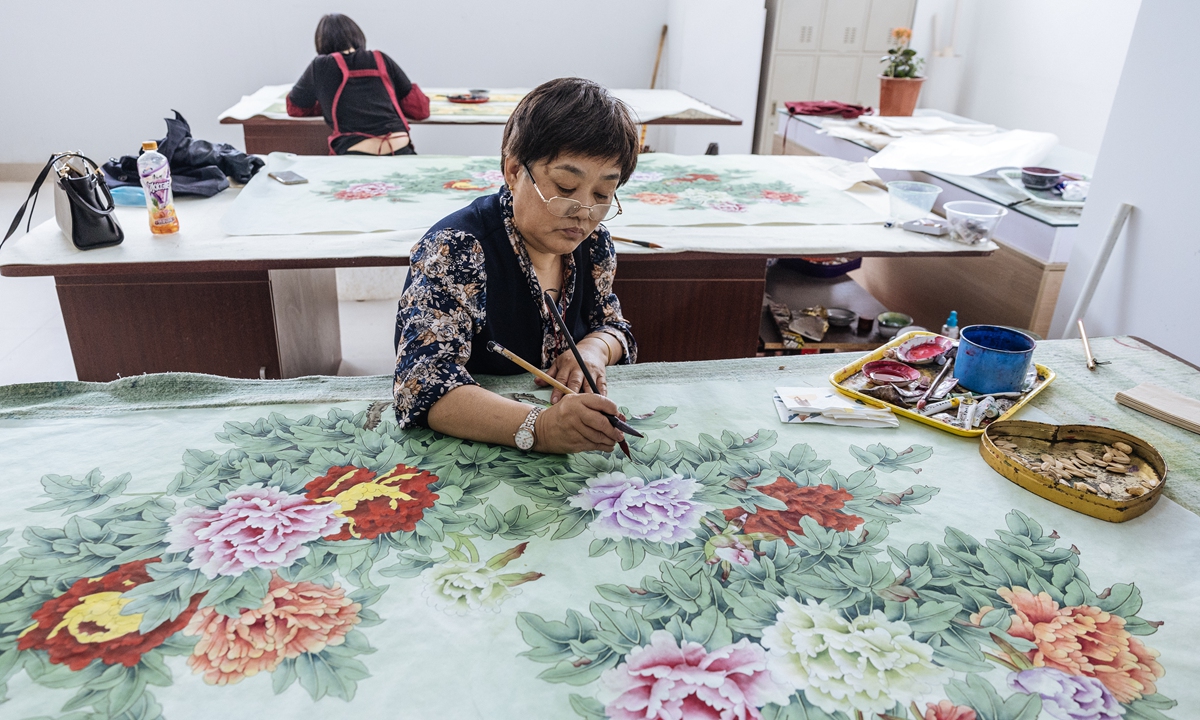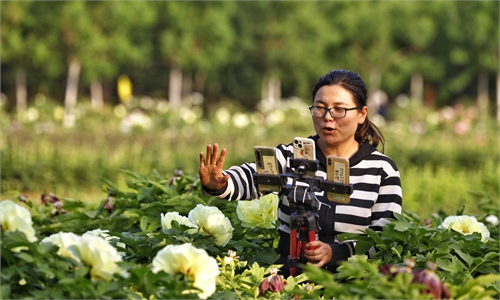IN-DEPTH / IN-DEPTH
'Hometown to peony' finds a characteristic path to modernization, rural vitalization thanks to policy lead, technological advancement
Blossom prosperity

Tourists appreciate cultivated peonies in Heze, East China's Shandong Province on April 19, 2023. Photo: Li Hao/GT
In spring, the city of Heze in East China's Shandong Province busies itself for peony blossom.
Tourists shuttle through the fields of peonies, admiring the precious flowers which bloom in various colors during the Heze International Peony Festival. The freshly-harvested peony flowers are shipped to all parts of the country and the rest of the world; farmers do live broadcasts in the flower fields; and machines surrounding factories process peony products.
Peony is considered the national flower of China, and its magnificent blooms are seen as a symbol of blessing and prosperity.
Thanks to its favorable climate, Heze has had a long history of growing peonies and is known as the "Home to Peony." In recent years, the region has turned this geographic and cultural advantage into a new form of development.
During an inspection tour to Shandong in 2013, Chinese President Xi Jinping visited Heze's peony industry base. He was impressed by the added value of peony developed by the city.
Over the last decade, how has the peony industry park in Heze developed? How does the peony industry drive local rural vitalization? How does technology play a role in peony cultivation and utilization? How is Heze's peony industry going global?
Recently, reporters visited the peony gardens and industrial parks in Heze, and talked to peony breeders, farmers, entrepreneurs, and local government. The regional case of Heze could showcase the characteristic development path of rural revitalization and the Chinese path to modernization.

A worker checks peony seed oil at the Heze Guyu Peony Biotechnology Co Ltd on April 19, 2023. Photo: Li Hao/GT
Peonies to the world
At the end of April, the temperature in Heze usually hits nearly 30 C. Zhang Xianguang wore a straw hat to protect himself from the sun. He took out a specially-made small knife and skillfully made a small incision on a peony branch, then grafted a flower bud from another peony onto it.
Behind this seemingly simple and quick action lies years of practical experience and technological innovation.
Zhang has been engaged in peony planting and cultivation for over 30 years. Now, he serves as the chief technician at the Guanyu Peony Garden in Huanggang town of Heze.
"We graft precious peony varieties onto sturdier peony varieties, increasing the survival rate of the precious varieties," Zhang told the Global Times with great passion, "We have also bred hundreds of new varieties, many of which are yet to be named."
Now, Zhang has many helpers who are mostly farmers from nearby villages. "The industrialization of peonies has become a sizable industry, driving many enterprises and individuals to prosper," Zhang said.
Take Guanyu garden as an example. It is not only a scenic spot in which tourists take photos in the sea of flowers, but also a farm, where those who have green thumbs can find the various peony plants they want.
According to Zhang, a 15-year-old peony plant in this garden could be valued at about 3,000 yuan ($867). In Heze, the oldest living peony plant there could be more than 400 years old.
Peony cultivation in Heze began during the Sui Dynasty (581-618), and flourished during the Tang Dynasty (618-907), reaching its peak during the Ming Dynasty (1368-1644). By the Qing Dynasty (1644-1911), Heze had become the center of peony cultivation in China, with a history of more than 1,500 years.
Currently, Heze's peonies have 9 color series, 10 flower types, and 1,280 varieties. The number of newly cultivated varieties accounts for 80 percent of the total in China, giving Heze's peonies unparalleled ornamental value.
Meanwhile, peonies are exported to more than 30 countries and regions, including the US, Russia, and the European Union. Many Heze peonies are now traded in the Netherlands, which is key to floral trade in the world.
This also is greatly aided by technological advances.
In terms of heritage, it used to be entirely field planting, and now it has basically become an industry with potted plants and cut flowers as the main high value-added products.
Previously, peony could only bloom during the Spring Festival, but now it can bloom all year round. The planting varieties and modes have been greatly improved, and the produced seedlings are more standardized. Scale production has also been achieved, which is more suitable for docking with foreign markets, the Global Times learned.
In recent years, Heze has exported more than 2 million peony seedlings annually, with an annual export value of about 6 million yuan, and has become the world's largest cultivation, research, processing, export, and ornamental base for peonies with the most diverse varieties.

An artist works on a peony painting at the Juye Painting and Calligraphy Institute on April 20, 2023. Photo: Li Hao/GT
Leading rural vitalization
In recent years, Shandong Province has continuously promoted the prosperity of peony culture and industry development based on Heze's peony resources. The peony industry has developed from a single ornamental plant to deep processing, cultural, and creative integration, shining the "Heze Peony" brand.
Nowadays, many entrepreneurs are constantly developing and producing new peony products while driving local employment and helping farmers accumulate wealth.
Li Xiaoqi is one such farmer. After graduated from the College of Horticulture at the China Agricultural University two decades ago, he chose to return to his hometown of Heze, which was relatively less-developed, to establish a startup.
"I want to use my knowledge and technology to promote the development of peonies in Heze. In recent years, I have seen real progress in this industry," Li, now the general manager at Heze Guyu Peony Biotechnology Co Ltd and Vice-Secretary General of Peony and Paeony Branch, China Flower Association, told the Global Times.
The Guyu company is located in the Export Demonstration Zone of the Heze Peony. A production line has been established to produce cold-pressed high-quality pure peony seed oil with an annual output of 1,000 tons.
"Peony seed oil is still a new concept to many people, but it has a high oil yield and is rich in essential fatty acids, which is essential for human health. It is expected to have a promising market in the future," Li said.
On Chinese e-commerce platforms, a bottle of 500ml peony seed oil goes for an average of 580 yuan ($83.8).
The oil is an example of the deep processing of cultivating peonies. Apart from this, for instance, the shells of peony seeds can be cycled for livestock feed.
The six towns nearby have more than 100,000 individuals working in the peony industry now, according to Li.
Now, Heze has developed more than 260 deep-processed products, including peony food and medicinal products, which are continuously improving, the Global Times learned.
"The development of the peony industry has played a significant role in rural vitalization, the construction of beautiful countryside, environmental improvement, and the promotion of local village brands," he concluded. "Therefore, for Heze, the peony industry is a traditional and ancient industry, but with the introduction of technology and young people's willingness to participate, it has injected great vitality into the old industry."
More opportunities
As the sun sets, the golden sunlight spills over the flower fields. Su Rui walks among them, using her mobile phone to showcase different peony varieties and cultivation experience to his fans.
The young live-streaming host from a neighboring village has more than 20,000 subscribers. She sells peonies directly from the fields to customers via platforms such as Douyin and Kuaishou. "In spring I promote fresh flowers, and in autumn I sell seedlings," she said, revealing that the sales revenue she accrues can reach up to 50,000 yuan a day.
She finds lots of fun doing live-streaming though it is not a relaxing job. Her success has also encouraged many people around her to join the team to promote local peonies.
The development in Heze has brought more opportunities for rural residents, especially women.
In Juye, a county administrated by Heze, rural women are encouraged to learn the traditional peony painting skills through free training in a campaign launched by the local government called "accompany the blossom."
Participating in peony painting offers rural women the chance to remain at home to care for their children, while also giving them the opportunity to discover their talent and develop a sense of self-value.
Juye is the hometown to traditional collaborative-style peony paintings, which is also significant in the county's rural vitalization strategy. In Juye, over 20,000 people are involved in the creation of collaborative-style paintings. Their artworks are sold worldwide.
Many peony artists come from a farming background.
In recent years, paintings from Juye have been showcased at key international events such as the Shanghai Cooperation Organisation (SCO) Qingdao Summit and the first China International Import Expo in Shanghai.
On May 2, the paintings, which represent the rich culture and history of Shandong, were on display at the 2023 UN Chinese Language Day event in Vienna, Austria.


